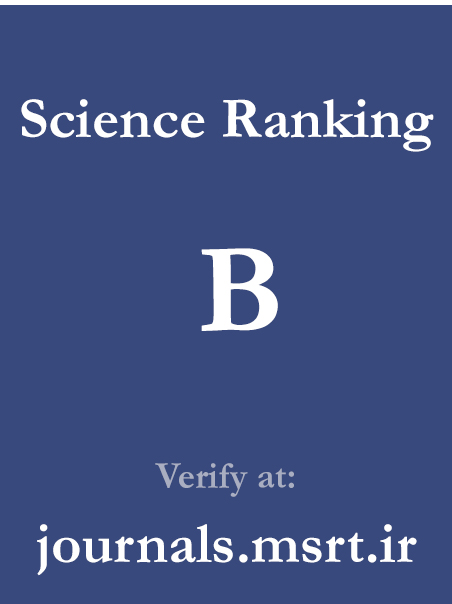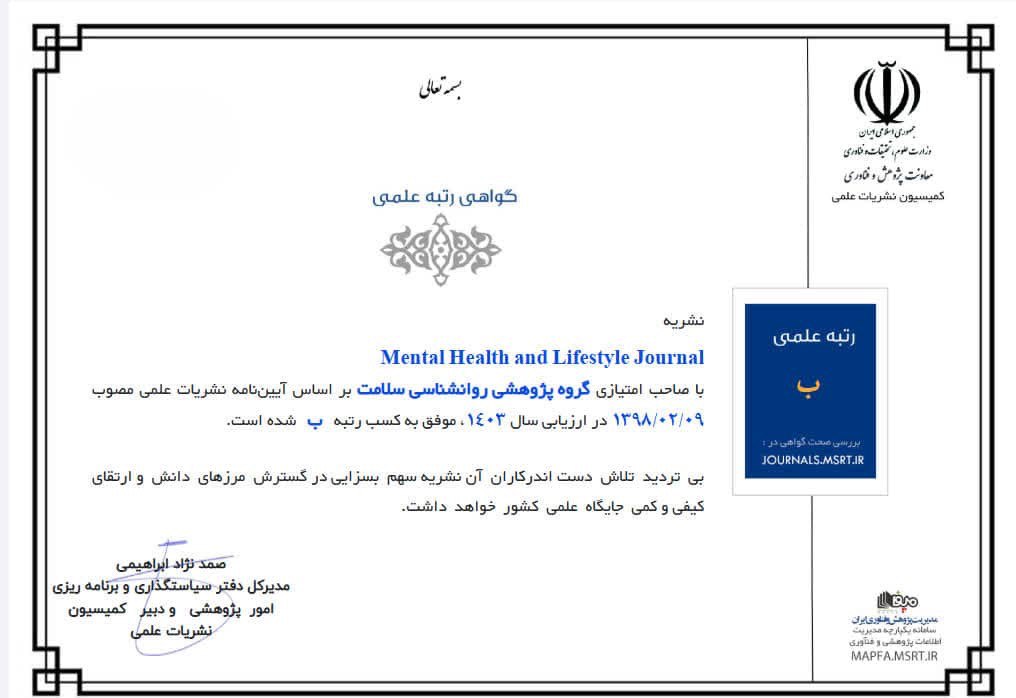Predicting Borderline Personality Disorder Symptoms Based on Childhood Trauma and Alexithymia With the Mediating Role of Mentalization in University Students
Keywords:
Borderline personality disorder, Childhood trauma, Alexithymia, Mentalization, University studentsAbstract
The present study aimed to predict borderline personality disorder (BPD) based on childhood trauma and alexithymia, with the mediating role of mentalization in university students. This study employed a descriptive correlational design. The statistical population included male and female students from three branches of the Islamic Azad University: Tehran Central (Sardar Soleimani Complex, Faculty of Psychology and Educational Sciences), Tehran West (Payambar Azam Complex, Faculty of Architecture and Art), and Shahre Qods (Faculty of Engineering). These branches were selected from among all branches of the Islamic Azad University in Tehran during the 2024–2025 academic year. The sample size was determined to be 300 participants based on the method proposed by Kline (1990), and they were selected through a non-random convenience sampling method. Data were collected using the Jackson and Claridge Borderline Personality Scale (1991), the Childhood Trauma Questionnaire by Bernstein and Fink (2003), the Toronto Alexithymia Scale (1985), and the Mentalization Scale by Fonagy et al. (2016). Statistical analyses were performed using SPSS version 28 and AMOS version 24. The results of data analysis showed that childhood trauma had a standardized coefficient of 0.175 on borderline personality disorder and the direction of the effect was positive. Additionally, alexithymia had a standardized coefficient of 0.334 on borderline personality disorder and the direction of the effect was positive. Furthermore, childhood trauma had no significant effect on borderline personality disorder through the mediating role of mentalization (p = 0.358). However, alexithymia had a significant effect on borderline personality disorder through the mediating role of mentalization (p = 0.016). Finally, the empirical model demonstrated acceptable and appropriate fit, and the overall model was confirmed. Childhood trauma and alexithymia play important roles in the emergence of borderline personality disorder symptoms, and mentalization served as a mediator only in the relationship between alexithymia and borderline personality disorder. These findings highlight the necessity of incorporating emotion regulation training and strengthening mentalization skills in preventive and therapeutic interventions.
Downloads
References
1. Ford JD, Courtois CA. Complex PTSD and borderline personality disorder. Borderline Personality Disorder and Emotion Dysregulation. 2022;9(1):20. doi: 10.1186/s40479-022-00184-y.
2. Saraiya TC, Fitzpatrick S, Zumberg-Smith K, López-Castro T, Back S, Hien D. Social-emotional profiles of PTSD, complex PTSD, and borderline personality disorder among racially and ethnically diverse young adults: A latent class analysis. Journal of Trauma Stress. 2024;34(1):56-68. doi: 10.1002/jts.22590.
3. Schulze L, Schmahl C, Niedtfeld I. Neural correlates of mentalization in borderline personality disorder. Current Psychiatry Reports. 2023;25(2):85-97.
4. Hesse T, Floyd K. Mentalization and personality disorders: Theoretical and clinical perspectives. Journal of Personality Disorders. 2021;35(5):665-82.
5. Bernstein DP, Fink L. Childhood Trauma Questionnaire: A Retrospective Self-Report: San Antonio, TX: The Psychological Corporation; 2003.
6. Porter C, Palmier-Claus J, Branitsky A, Mansell W, Warwick H, Varese F. Childhood adversity and borderline personality disorder: A meta-analysis. Acta Psychiatrica Scandinavica. 2020;141(1):6-20. doi: 10.1111/acps.13118.
7. Yuan A, Li X, Ike D, Nevill RE. Childhood maltreatment and borderline personality disorder: A systematic review and meta-analysis. Psychiatry Research. 2023;324:115159.
8. Zhang J, Li X, Ike D, Neville H. Childhood maltreatment and borderline personality disorder: A meta-analytic review. Psychiatry Research. 2022;309:114438.
9. Danese A, Baldwin JR. Hidden wounds? Inflammatory links between childhood trauma and psychopathology. Annual Review of Psychology. 2017;68:517-44. doi: 10.1146/annurev-psych-010416-044208.
10. Bozzatello P, Rocca P, Baldassarri L, Bosia M, Bellino S. The role of trauma in early onset borderline personality disorder: A biopsychosocial perspective. Frontiers in Psychiatry. 2021. doi: 10.3389/fpsyt.2021.721361.
11. Hoffman ML, Vernoy J. Emotion and Social Development Handbook of Psychology: Wiley; 2002. 189-212 p.
12. Balls A, Sharp C, Fonagy P. Childhood trauma, impaired mentalization, and borderline personality disorder: A systematic review. Psychopathology. 2023;56(4):183-96.
13. Milan S, Barbosa L. Childhood Maltreatment History and Borderline Personality Symptoms: The Role of Mentalization Difficulties Among Vulnerable Women. Journal of Personality Disorders. 2023;37(4):369. doi: 10.1521/pedi.2023.37.4.369.
14. Sabour S, Zarbakhsh M, Khanehkeshi A. A Structural Model of Borderline Personality Syndrome Based on Childhood Trauma Experience and Emotion Dysregulation with the Mediating Role of Mentalization. Journal of Psychological Sciences. 2023;22(143):55-72.
15. Taylor GJ, Bagby RM. An Overview of the Alexithymia Construct. Handbook of Emotional Intelligence: Jossey-Bass; 2000. p. 40-67.
16. Sifneos PE. Alexithymia, clinical issues, and affect regulation. American Journal of Psychotherapy. 2000;54(1):83-95.
17. Bagby RM, Parker JDA, Taylor GJ. The twenty-item Toronto Alexithymia Scale-I: Item selection and cross-validation of the factor structure. Journal of Psychosomatic Research. 1994;38(1):23-32. doi: 10.1016/0022-3999(94)90005-1.
18. Taylor GJ, Ryan DP, Bagby RM. Toward the development of a new self-report alexithymia scale. Psychotherapy and Psychosomatics. 1985;44(4):191-9. doi: 10.1159/000287912.
19. Liebl C, Günther V, Zimmermann J. Alexithymia and borderline personality disorder: A longitudinal study. Journal of Personality Disorders. 2023;37(5):673-92.
20. Uzar M, Dmiterzak-Węglarz M, Stopien A. Mentalization in Adolescents with Borderline Personality Disorder. 2023.
21. Debbané M, Fonagy P, Luyten P, Bateman A. Mentalizing as a protective factor linking alexithymia and borderline personality disorder. Frontiers in Psychiatry. 2024;15:1361535.
22. Fonagy P. Attachment Theory and the Development of Mentalization: New York, NY: Routledge; 2018.
23. Bora E. Meta-analysis of social cognition in borderline personality disorder: Mentalizing, empathy and theory of mind. World Psychiatry. 2021;20(1):132-50.
24. Fonagy P, Luyten P, Moulton-Perkins A, Lee YW, Warren F, Howard S, et al. Development and validation of a self-report measure of mentalizing: The Reflective Functioning Questionnaire. PLoS ONE. 2016;11(7):e0158678. doi: 10.1371/journal.pone.0158678.
25. Shirazi A, Ghasemi M, Esmaeili-Shad B, Bakhshipour A. Modeling Borderline Personality Symptoms Based on Attachment: The Mediating Role of Self-Differentiation and Mentalization. Scientific-Research Quarterly of Psychology. 2022;3(4):85-104. doi: 10.61838/kman.jayps.4.3.14.
26. Darvagar N, Fathi-Ashtiani A. Investigating the Relationship Between Mentalization and Emotion Regulation in Personality Disorders. Clinical Psychology Quarterly. 2020;12(3):55-70.
27. Eini S, Narimani M. The Role of Mentalization Capacity in Predicting Symptoms of Borderline Personality Disorder. Journal of Contemporary Psychology. 2019;14(2):101-18.
28. Safari Moosavi F, Ahmadi M, Rostami S. The Relationship Between Childhood Traumatic Experiences and Mentalization in a Non-Clinical Population. Journal of Developmental Psychology. 2021;17(1):77-92.
29. Farjami M, Farjami Z, Aram Shakibaei-Nejad L, Paeezy L. Developing a Model of Self-Harm Behaviors Based on Childhood Trauma Experience and Alexithymia with the Mediation of Mentalization in Adolescents. Journal of Psychiatric Nursing. 2024;12(1):1-15
Downloads
Published
Submitted
Revised
Accepted
Issue
Section
License
Copyright (c) 2025 Zahra Shirazi (Author); Mansooreh Fazilati

This work is licensed under a Creative Commons Attribution-NonCommercial 4.0 International License.









